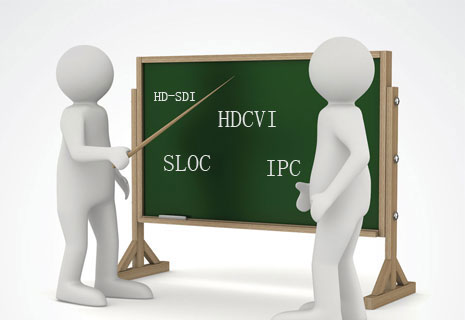HDCVI vs HD-SDI, HDCVI camera vs IP camera
HDCVI is based on coaxial cable to transmit composite video signal brand-new technology, adopting analog signal modulation technology, and progressive scan CMOS image sensor to deliver 1280H (1280x720) and 1920H (1920x1080) high definition video signal. HD-CVI technology can output megapixel resolution, including 1280H@25fps, 1280H@30fps, 1280H@50fps, 1280H@60fps, 1920H@25fps, 1920H@30fps six formats. Adopting the HDCVI technology can achieve uncompressed, lossless, without delay video transmission between HDCVI camera and HDCVI DVR. More over, HDCVI can transmit audio and control signal, up to 500 meters long range transmission distance.

HDCVI vs HD-SDI
Compared with HD-SDI technology, HDCVI has advantages in high definition analog coaxial cable transmission field.
Firstly, HDCVI and HD-SDI, both of them can transmit 720P and 1080P high definition video, but HDCVI support much far transmission distance; HD-SDI requires high quality coaxial cable for video transmission, the farest distance is 100 meters, even HD-SDI cameras adopt HDcctv v2.0 compression technology, the HD-SDI can reach up to 300 meters theoretically. When using 75-3 coaxial cable, the HDCVI can transmit 500 meters, and with low signal disorder; Using 75-5 or better quality coaxial cable, the transmission range can expand, also can increase the image quality.
Secondly, HD-SDI is vulnerable to interference, especially equipment is working under high RF environment, such as cell phone, WiFi router...etc. The strong RF will cause interference to HD-SDI video transmission, which in turn generate image disorder. HDCVI adopts low frequency modulation technology, this technology can avoid the High RF interference, the HD-CVI can transmit high quality image even under strong RF environment.
Lastly, HD-SDI requires strict installation, including cable wiring, and layout, mainly it requires using high quality coaxial cable, midway connection is prohibited. On the other hand, HDCVI technology inherited the traditional installation standard, which means if you can install the standard analog cameras, you can also install HDCVI cameras.
HDCVI vs IP
Compared with the main trend of HD IP cameras, HD-CVI also have its unique advantages.
Firstly, HDCVI adopts point to point transmission, which ensures the reliability of transmission. IP camera adopts Ethernet transmission technology, which data transmits through network switch, router...etc, with risk of data bag loss. In order to get adapted into network environment to offer smooth video, normally, IP cameras use video buffering technology, which means it will cause video latency effect. Even under good network condition, the video delay can be controlled within 300ms. HDCVI technology supports point to point transmission, without any video delay, the HD video streaming convey from camera to DVR without video compressing, and images keep original effect.
Secondly, the current standard surveillance equipment can be easily upgraded with HD-CVI products, through replacing the camera and DVR, user can upgrade its existing surveillance system to high definition system. HDCVI inherited the standard analog video transmission, security installer and user don't need to learn new knowledge for the HD-CVI installation. For the IP system, this technology requires Ethernet cable (Cat5, Cat6) for data transmission, which means making the upgrading impossible for standard analog cctv system with IP equipment.
Last, HDCVI shares the same standard like the traditional cctv system, analog camera and DVR support plug-and-play installation, all major configurations on DVR. Compared with HDCVI, IP system requires user to set parameters for each of IP cameras. IP system also has compatibility issue which limited the flexibility of IP equipment selection and installation. Although IP security equipment has Onvif standard, user may still encounter compatibility issue.
Get My Latest Posts
Subscribe to get the latest updates.
Your email address will never be shared with any 3rd parties.